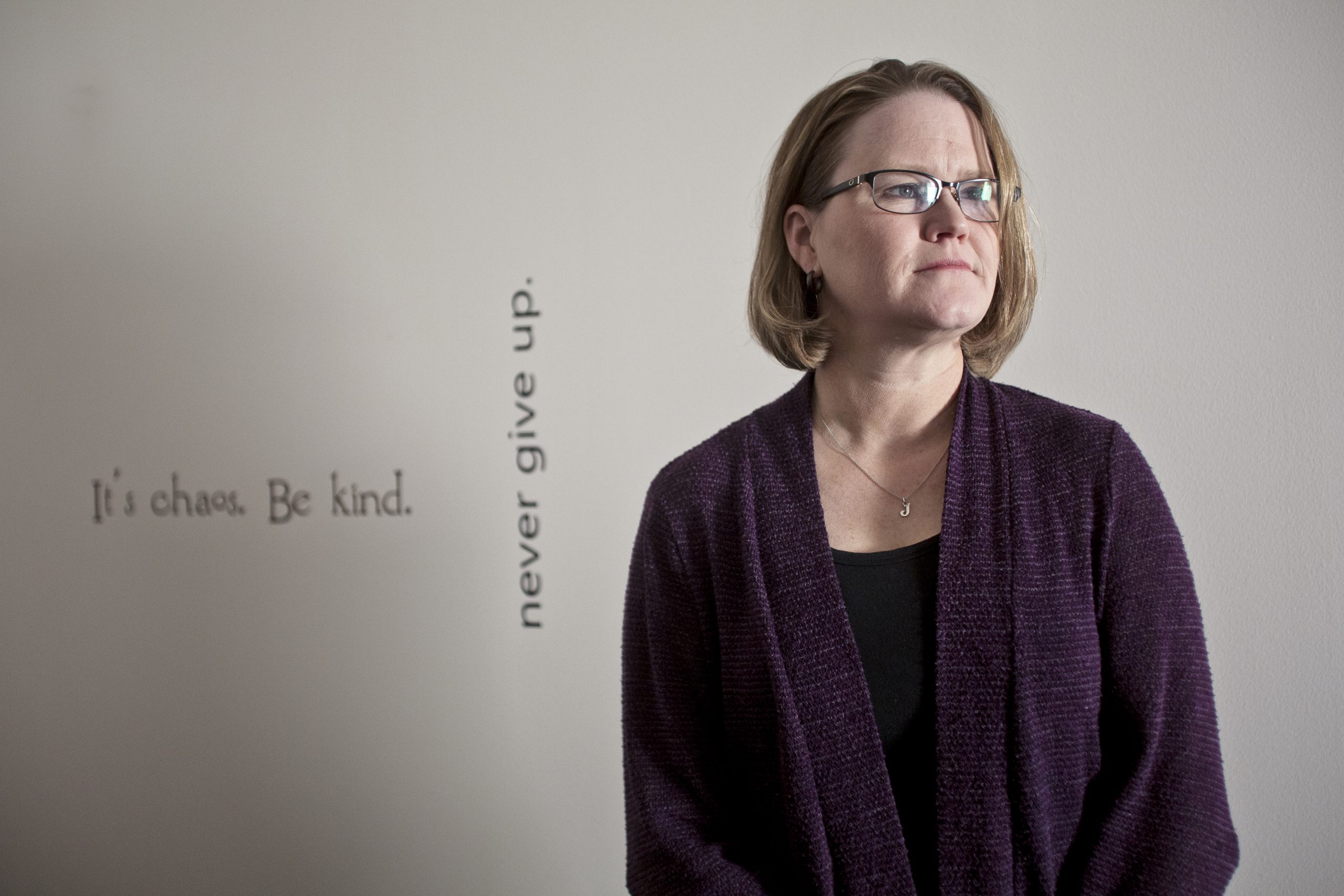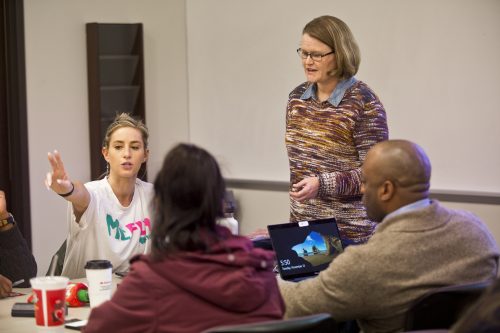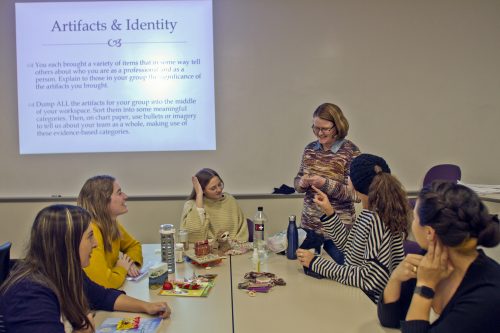Looking Past Test Scores for School Success
Are teachers happy? Do students like the library? Jo Beth Jimerson looks beyond numbers.

Jo Beth Jimerson, associate professor of education, is an expert on applying big data sets to improve school leadership. Photo by Mark Graham
Looking Past Test Scores for School Success
Are teachers happy? Do students like the library? Jo Beth Jimerson looks beyond numbers.
In her first year as an administrator in a middle school, Ebony Love ’19 MEd had a special-needs student who could become aggressive to the point of endangering teachers and fellow students. Love asked staff members who interacted with the student to collect a range of data, from peer interactions to diet.
“We discovered that before going into a state of crisis, this student would say the phrase, ‘I have an idea,’ ” said Love, who was an assistant principal at Ed Willkie Middle School in the Eagle Mountain-Saginaw Independent School District near Fort Worth and now works for the Texas Education Agency. “That cue and other things we learned from the data ultimately helped us find ways to lower the amount of incidents.”
Love credits much of that success to Jo Beth Jimerson, associate professor in TCU’s Educational Leadership program. The professor has a passion for equipping the next generation of school leaders with tools for growth and change.
Jimerson, who teaches graduate students almost exclusively, champions a broad vision of data, one that goes far beyond commonly collected numbers. Her goal is to improve student experiences in public schools.
While conducting research, Jimerson often encounters teachers and school principals who recoil at the mention of data. The word can trigger a single thought: STAAR scores from the standardized tests that most public school students in Texas take annually.
“But data can be parent surveys and health information, homework assignments and even quick face-to-face checks with students on how they are feeling,” Jimerson said. “The information from standardized tests can be good for short-term problem-solving, but it’s a little harder when you are trying to look for root causes of underperformance.”
Thanks in part to a two-year grant from the Chicago-based Spencer Foundation, Jimerson did a deep dive into data collection with a pilot program in two Fort Worth-area schools that looked at improving a specific problem over the course of the year.
At an elementary school, administrators and teachers identified student motivation — or lack of it — as a core problem. Educators on a middle school campus, meanwhile, wanted to see improvement in reading.
Back to Class
As the daughter of a teacher and a school superintendent who attended a small, well-regarded Texas Gulf Coast high school, Jimerson seemed destined for a career in the classroom. She worked for 13 years as a public school teacher and administrator in the Comal Independent School District in New Braunfels, Texas. She left to complete graduate studies in educational leadership, her research fueled by curiosity about how data was being used in the field and a desire to find more constructive approaches.
At the time, Texas educators were locked in debates over the role of standardized tests, Jimerson said, noting that those discussions and disagreements continue. Public school teachers may feel acute pressure to raise class scores, while many administrators, teachers and parents rue a culture of “teaching to the test.”
“The STAAR exam is stressful on everyone, including teachers and administrators,” said Khourie Jones ’13 MEd, the principal of R.F. Patterson Elementary School in the Kennedale school district near Fort Worth. Jimerson is Jones’ doctoral adviser.

Jo Beth Jimerson listens to student Savannah Gaudreau. Jimerson teaches students to look at data and find constructive approaches. Photo by Mark Graham
“My own kids started stressing out in kindergarten, saying they didn’t want to go to third grade because they’d have to take the STAAR test,” Jones said. “It’s such a huge focus on most campuses, but it doesn’t need to be.”
To that end, Jimerson champions a broad vision of non-test-related data that includes everything from parent surveys and input from the child to teachers self-reporting on their happiness at work.
“My focus has always been on getting us to figure out the mystery behind every learner,” she said. “Data can be wonderful for clues for teachers who know how to collect it and use it in a meaningful way.”
For one thread of research, Jimerson collaborated with Vanessa Garry, an assistant professor of education at the University of Missouri-St. Louis. Jimerson and Garry worked to adapt a study conducted by Kim Schildkamp and Cindy Poortman of the University of Twente in the Netherlands for several U.S. public schools.
Schildkamp and Poortman helped devise a model that begins with the assumption that data can make a positive impact on student and school outcomes, but only if educators locate and use the information effectively.
The model does not start with data, however. Teachers and school administrators participating in a data team must prioritize a problem on their campus. From there, they identify a related goal with measurable outcomes.
Data collection begins with agreement among educators that the problem is actually a problem. They then identify supporting evidence that might indicate the problem’s extent.
Next the team formulates assumptions about the cause of the problem. They systematically collect related data by using assignments, grades and interviews with students or other reliable sources that help point to possible causes.
The team analyzes findings and draws conclusions about the cause of the problem. “Only then can an improvement action be taken, one which also needs to be evaluated after implementation,” Poortman said. “So both the process and the effects are evaluated.”
Data teams meet every three to five weeks over an academic year to structurally and systematically solve their problem. The goal is not only to solve this problem but also to develop the participants’ professional skills and promote sustainable data use in the school.
Although data-use interventions, including Harvard’s Data Wise Project, are common these days, few have been studied scientifically with specific attention to student-level outcomes, Poortman said. “The data-team procedure is one of those exceptions.”
“There’s a danger of using kids as a means to an end, like raising school ratings. … Kids aren’t tools to advance careers, but data is a tool that can help educators support kids.”
Jo Beth Jimerson
This model places emphasis on staff who experience an educational problem, rather than on upper-level administrators or outside consultants. Teachers, Poortman said, make decisions on what needs to improve within their campuses and classrooms.
School improvement work “is very accountability-centered,” Jimerson said. “There’s a danger of using kids as a means to an end, like raising school ratings. The focus of my career has been the students. Kids aren’t tools to advance careers, but data is a tool that can help educators support kids.”
Study Time
During the 2017-18 school year, Jimerson worked with an elementary school in a suburb of Fort Worth. Adopting the Dutch model, she began by asking teachers and school leaders what they wanted to improve. The answers came down to a central question: How can educators inspire more students to be motivated to do their best work?
Jimerson helped the staff create a checklist for teachers to use to assess what motivation looked like.
Students turning work in on time and making corrections without being asked were among the items the teachers and administrators agreed were hallmarks of motivated behavior.
For two weeks, teachers collected initial data about the motivation problem. “When we came back to the table, it was fun to hear them say this wasn’t what they thought would happen,” Jimerson said. “Some had students who hadn’t turned in stuff and were missing assignments but were still getting A’s on their tests.” At the same time, other students were doing everything asked of them and were failing or barely passing.
The surprising data conflicted with some deeply held assumptions about the root causes of classroom problems. At the same time, Jimerson was surprised to discover how little time at the school was dedicated to formal data collection and use.
Jimerson’s elementary school study yielded no immediate fix, in part because identifying the central question took so much time. Not so with the middle school she studied the following school year.
Year Two
Jimerson spent the 2018-19 academic year making regular visits to a middle school in Fort Worth to help teachers and administrators assess and address a problem of their choosing: a perceived lack of interest in reading among young Black males.
Jimerson helped conduct a campuswide survey that asked students if they liked to read, what they didn’t like to read, the perception of reading in their social circles and more.
“What we found out looking at the data was that [the school] didn’t have a problem with African American males and reading engagement,” Jimerson said. “They had a problem with reading engagement, period.”

Jo Beth Jimerson, associate professor of education, shows students how data can be used to improve public schools. Photo by Mark Graham
Surveys indicated the offerings in the school library didn’t resonate with the students, contributing to their lack of enthusiasm. The middle schoolers wanted shelves stocked with comic books, graphic novels and magazines, particularly anything pertaining to video games.
School leaders took note and examined certain policies, including one that allowed students to check out only one graphic novel at a time “because those weren’t seen as real reading,” Jimerson said. “Another decision they made based on the survey was to revamp their library into a learning space rather than just a place to go check out traditional books.”
Now the space Jimerson described as a dead zone has been transformed into a lively spot filled with technology and appealing printed materials.
Agents of Change
The library upgrade shines a light on a guiding principle of Jimerson’s career: “If you take the time to do it right, data can be a powerful tool, but you have to guard against this idea that data is only test scores.”
“Once I recognized how important data collection was, I actually now take pencil to paper, tracking the teacher’s path in a 20-minute period in the classroom,” said Darryl Gentry ’16 MEd, principal at High Desert Middle School in Globe, Arizona, and one of Jimerson’s former students.
“I take a map of the seating chart and see how the teacher is connecting with students on the path she walks,” Gentry explained. “All of that can be impactful, but that kind of data — looking to make sure we are approaching every kid every day — is something I learned from Dr. Jimerson.”
And educators often find that the results justify the time spent collecting the data.
“What I try to impart to my teachers is not to look at data as the extra thing we do on our plate. Data should be the plate,” said Justin Hennig ’19 MEd, an assistant principal at Timberview Middle School in Keller, a Fort Worth suburb. “There are questions we need to continually ask, like if we’re showing a video, are there enough students in the class who are visual learners that it’s going to connect with the group? Data is at the heart of those questions.”
One thing Charley Erwin ’16 MEd, the principal at Timberview, chose to focus on while working as an intern and studying under Jimerson was teacher happiness data, “which isn’t necessarily about crunching numbers,” he said. Determined to create a more positive culture, Erwin implemented a weekly newsletter that over the year highlighted almost every teacher on campus.
“Dr. Jimerson’s focus on data had the effect of making me more intentional in communication.”
Charley Erwin
“Dr. Jimerson’s focus on data had the effect of making me more intentional in communication,” Erwin said, noting that he has brought the lessons from that newsletter to all three public schools where he has worked following graduation from TCU.
Spreading the Word
In 2018, Jimerson and her colleague and co-editor, Sarah Quebec Fuentes, associate professor of mathematics education, published Instructional Leadership in the Content Areas: Case Studies for Leading Curriculum and Instruction (Routledge, and co-published with the University Council for Educational Administration).
The chapters were written by educators, who often use real-life case studies to support solutions to common problems. TCU’s Curby Alexander, associate professor of professional practice in education, contributed two chapters, including “Teaching With Technology: Promoting Responsible, Safe and Legal Digital Citizenship.”
“Dr. Jimerson and Dr. Fuentes were looking for something broad enough that a school principal or an aspiring school principal could get a pretty decent overview of the variety of issues they could expect in their school,” said Alexander, who has built a career studying technology integration in public schools.
Those issues — snapshots in the form of case studies — include plagiarism, inappropriate use of technology such as cyberbullying and teacher use of technology in the classroom.
Alexander’s research is informed by interviews with students and teachers, questionnaires and other knowledge gleaned from work experience, particularly the year he spent as a technology specialist at Good Shepherd Episcopal School in Dallas.
Other chapters in Instructional Leadership in the Content Areas examine everything from developing creativity through visual arts to how book clubs can spur engagement in middle school classes.
“To be an instructional leader, you need to have all this leadership across content areas, but that’s too hard to do,” Fuentes said. “Our argument is that you don’t have to be that ideal going into the role of principal. Over time, you can gain knowledge over content areas so you can support your teachers.”
As a lifelong learner, Jimerson seeks to educate herself and her students about best practices in the classroom by soaking up studies, strategies and successes.

Jo Beth Jimerson teaches future school leaders how practical data can be used to improve education. Photo by Mark Graham
Supporting emerging school leaders remains a primary focus of her work. Most of her students are following a path similar to her own by pursuing advanced degrees after years spent teaching school. Most will become public school principals and assistant principals.
“Teaching really is a learning experience,” Jimerson said. “Once they become school leaders, there’s definitely a pressure to get everything right very quickly, even though sometimes people don’t have the tools and the data and the resources to get it right really quickly.”
Such pressure can become intense for school leaders when standardized-test benchmarks fail to meet expectations. “We shouldn’t be making a high-stakes decision based on one test score,” Jimerson said. “That’s not an appropriate use of any data point.”
School leaders also face challenges in evaluating teacher performance, particularly if the principal has only passing familiarity with a given subject. This, too, circles back to the data: Principals might rely almost exclusively on test scores in the absence of real understanding about a subject.
Integrating findings and creating a workable plan can be tricky.
“From a practical standpoint, I always try to remind teachers that just because there are different stories that can be told from different datasets, it doesn’t mean that there aren’t aspects of truth from those datasets,” Hennig said. “This possibility can be true, and that possibility can be true. It’s about really mining the data and [being] open to what you’re hearing.”
Jimerson encourages an open-minded approach in her own classroom: “As a principal or assistant principal, being a co-learner with your teachers not only builds your understanding of what should be happening in those classrooms,” she said, “but it gives you a lot of credibility from those teachers.”

Your comments are welcome
Comments
Related reading:
Alumni
Alan Royal Promotes Equity and Inclusion to Help Scholars Succeed
The alumnus mentors young students as they pursue higher education and careers.
Campus News: Alma Matters
Faculty Discuss Happiness
When and where were you happiest in life?
Features
TCU Partnerships Shape the Future of Medicine
Leadership programs at two Fort Worth hospitals take physicians into uncharted territory.